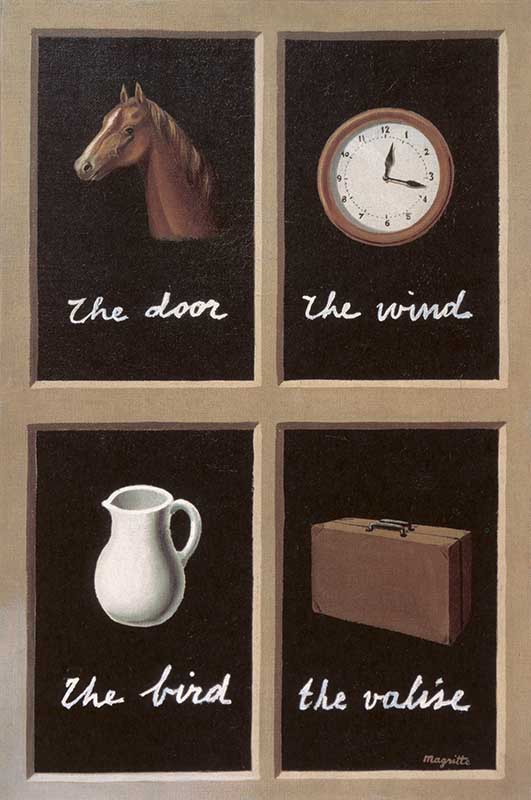
Seeing comes before words. The child looks and recognizes before it can speak.
But there is also another sense in which seeing comes before words. It is seeing which establishes our place in the surrounding world; we explain that world with words, but words can never undo the fact that we are surrounded by it. The relation between what we see and what we know is never settled. Each evening we see the sun set. We know that the earth is turning away from it. Yet the knowledge, the explanation, never quite fits the sight. The Surrealist painter Magritte commented on this always-present gap between words and seeing in a painting called The Key of Dreams.

The way we see things is affected by what we know or what we believe. In the Middle Ages when men believed in the physical existence of Hell the sight of fire must have meant something different from what it means today. Nevertheless their idea of Hell owed a lot to the sight of fire consuming and the ashes remaining – as well as to their experience of the pain of burns.
When in love, the sight of the beloved has a completeness which no words and no embrace can match : a completeness which only the act of making love can temporarily accommodate.
Yet this seeing which comes before words, and can never be quite covered by them, is not a question of mechanically reacting to stimuli. (It can only be thought of in this way if one isolates the small part of the process which concerns the eye’s retina.) We only see what we look at. To look is an act of choice. As a result of this act, what we see is brought within our reach – though not necessarily within arm’s reach. To touch something is to situate oneself in relation to it. (Close your eyes, move round the room and notice how the faculty of touch is like a static, limited form of sight.) We never look at just one thing; we are always looking at the relation between things and ourselves. Our vision is continually active, continually moving, continually holding things in a circle around itself, constituting what is present to us as we are.
Soon after we can see, we are aware that we can also be seen. The eye of the other combines with our own eye to make it fully credible that we are part of the visible world.
If we accept that we can see that hill over there, we propose that from that hill we can be seen. The reciprocal nature of vision is more fundamental than that of spoken dialogue. And often dialogue is an attempt to verbalize this – an attempt to explain how, either metaphorically or literally, ‘you see things’, and an attempt to discover how ‘he sees things’.
In the sense in which we use the word in this book, all images are man-made.
An image is a sight which has been recreated or reproduced. It is an appearance, or a set of appearances, which has been detached from the place and time in which it first made its appearance and preserved – for a few moments or a few centuries. Every image embodies a way of seeing. Even a photograph. For photographs are not, as is often assumed, a mechanical record. Every time we look at a photograph, we are aware, however slightly, of the photographer selecting that sight from an infinity of other possible sights. This is true even in the most casual family snapshot. The photographer’s way of seeing is reflected in his choice of subject. The painter’s way of seeing is reconstituted by the marks he makes on the canvas or paper. Yet, although every image embodies a way of seeing, our perception or appreciation of an image depends also upon our own way of seeing. (It may be, for example, that Sheila is one figure among twenty; but for our own reasons she is the one we have eyes for.)
Images were first made to conjure up the appearances of something that was absent. Gradually it became evident that an image could outlast what it represented; it then showed how something or somebody had once looked – and thus by implication how the subject had once been seen by other people. Later still the specific vision of the image-maker was also recognized as part of the record. An image became a record of how X had seen V. This was the result of an increasing consciousness of individuality, accompanying an increasing awareness of history. It would be rash to try to date this last development precisely. But certainly in Europe such consciousness has existed since the beginning of the Renaissance.
No other kind of relic or text from the past can offer such a direct testimony about the world which surrounded other people at other times. In this respect images are more precise and richer than literature. To say this is not to deny the expressive or imaginative quality of art, treating it as mere documentary evidence; the more imaginative the work, the more profoundly it allows us to share the artist’s experience of the visible.







